Iterative solutions for variational inclusion problems in Banach spaces
2 Mathematics Department, Nnamdi Azikiwe University, Awka, Anambra State, Nigeria, Email: drchikamoore@yahoo.com
Received: 06-Jun-2021 Accepted Date: Jun 08, 2021; Published: 16-Jun-2021, DOI: 10.37532/2752-8081.21.5.35
Citation: Anyaiwe OED, Moore C. Iterative solutions for variational inclusion problems in Banach spaces. J Pur Appl Math. 2019;3(1): 01-04.
This open-access article is distributed under the terms of the Creative Commons Attribution Non-Commercial License (CC BY-NC) (http://creativecommons.org/licenses/by-nc/4.0/), which permits reuse, distribution and reproduction of the article, provided that the original work is properly cited and the reuse is restricted to noncommercial purposes. For commercial reuse, contact reprints@pulsus.com
Abstract
Variational inclusion problems have become the apparatus that is generally used to constrain sundry mathematical equations in other to pguarantee the uniqueness and existence of their solutions. The existence of these solutions was earlier studied and proven for uniform Banach Spaces using accretive operators. In this study, we extend the conditions to hold for arbitrary Banach Spaces using uniform accretive operators.
Keywords
Accretive operators; Banach spaces
In recent years, variational inequalities have been extende in different directions and areas of studies, using novel and innovative techniques. One of such generalization is variational inclusions. Several problems that occur in engineering, optimization and control situations can be modeled by free boundary problems which leads to variational inequality and variational inclusion problems, Eq. 1 in appropriate spaces.
Definition
(Variational Inclusion Problem). Let  be two set-valued mappings,
be two set-valued mappings,  an m-accretive mapping,
an m-accretive mapping, a single valued mapping and
a single valued mapping and  a nonlinear mapping. For any given function
a nonlinear mapping. For any given function  and
and  , we consider the following problem. Find q
, we consider the following problem. Find q such that
such that (1)
(1)
Where E is a real Banach space and E* is its topological dual space. CB (E) is the family of all non-empty convex (closed) and bounded subsets of E.
The duality pairing between E and E*is defined by inner product  if E is a Hilbert space and the Hausdorff metric D (.,.) on CB(E) is defined by
if E is a Hilbert space and the Hausdorff metric D (.,.) on CB(E) is defined by

Given that A, B∈CB(E) , the distances d(x,B) or d(A, y) is defined by
 (2)
(2)
Also, D (T) denotes the domain of T and the normalized duality map is defined by
 (3)
(3)
Variational inequalities were introduced in early nineteen sixties by Hartman and Stampachia [1].
Lemma I.1 (Micheal’s Selection Theorem). Let X and Y be two Banach spaces;  a lower semicontinuous mapping with nonempty closed convex values. Then T admits a continuous selection i.e. there exists a continuous mapping
a lower semicontinuous mapping with nonempty closed convex values. Then T admits a continuous selection i.e. there exists a continuous mapping  such that
such that for each
for each
Lemma I.2
Let E be a uniformly smooth Banach space and  be a lower semicontinuous and m-accretive mapping. Then the following conditions hold; (a) T admits a continuous and m-accretive selection
be a lower semicontinuous and m-accretive mapping. Then the following conditions hold; (a) T admits a continuous and m-accretive selection
(b) If T is also  strongly accretive, then T admits a continuous m-accretive and
strongly accretive, then T admits a continuous m-accretive and  strongly accretive selection.
strongly accretive selection.
Lemma I.3
Nadler’s Theorem). Let E be a complete metric space,  be a set-valued mapping then for any given ∈> 0 and for any given
be a set-valued mapping then for any given ∈> 0 and for any given  , there exists v∈Ty such that
, there exists v∈Ty such that
 (4)
(4)
Algorithm I.4
(Iterative Sequence). For any given  compute the sequence
compute the sequence by the iterative scheme
by the iterative scheme
For 

For  ,
,
 (5)
(5)
Eq. 5, is called the Mann iterative sequence, it is a direct consequence of invoking Michael’s Selection theorems [2]. Using Nadler’s theorem [3], Chang in [4] proved Lemma I.2, thereby establishing the existence of unique solutions to Variational Inclusion problems using accretive operators in uniform Banach Spaces. In this work we present the extension of Chang’s work to arbitrary Banach Spaces using uniformly accretive operators based on the Lipschitz property of T and F.
Preliminaries
Definition I.2.
Let A be a set-valued mapping with domain D(A) and range R(A) in E. A is said to be accretive if for all  there exists
there exists such
such (6)
(6)
Definition I.3.
Let  be a strictly increasing function with
be a strictly increasing function with  then the mapping A is strongly accretive if for an
then the mapping A is strongly accretive if for an , and
, and 
 (7)
(7)
If  then A is said to be k-strongly accretive, and said to be m-accretive if A is accretive and (I + rA)D(A) = E for all r > 0, where I is the identity mapping.
then A is said to be k-strongly accretive, and said to be m-accretive if A is accretive and (I + rA)D(A) = E for all r > 0, where I is the identity mapping.
Theorem I.5
Let E be a uniform smooth Banach space,  and
and  be three set-valued mappings, q : E−D(A) a single valued mapping satisfying the following conditions;
be three set-valued mappings, q : E−D(A) a single valued mapping satisfying the following conditions;

(iv)The mapping  strongly accretive with respect to the mapping T, and
strongly accretive with respect to the mapping T, and  is a strictly increasing function with φ (0) = 0
is a strictly increasing function with φ (0) = 0
(v) The mapping  is accretive with respect to the mapping F Then, for any given
is accretive with respect to the mapping F Then, for any given  , there exists
, there exists which is a solution to Eq. 1.
which is a solution to Eq. 1.
Theorem I.6
Let E, T, F, A, g, and N be as in Theorem
I.5 and  , be a sequence in the closed interval [0, 1] satisfying the following conditions
, be a sequence in the closed interval [0, 1] satisfying the following conditions

If the ranges  and
and  are bounded, then for any given
are bounded, then for any given  , the iterative sequences {xn}, {un} and {vn} defined by Algorithm I.4 converges strongly to the solution q, u, z of the set-valued vibrational inclusion problem of Eq. 1
, the iterative sequences {xn}, {un} and {vn} defined by Algorithm I.4 converges strongly to the solution q, u, z of the set-valued vibrational inclusion problem of Eq. 1
An equivalent form of Theorem I.6 is given as lemma [5].
Lemma I.7
(Moore and Nnoli). Let {an}, {n} and {n} be real sequences such that  Also, let
Also, let be a strictly increasing function with
be a strictly increasing function with if
if .
.
We are not going to reproduce the proofs of these Theorems and Lemmas, it suffices to indicate their implications, conclusions and some of their rudiments as they are used in the course of this paper. For instance, to prove Theorem I.5, one defines the mapping  that is expressed by
that is expressed by  and invoke Morales [6] to establish that S is m-accretive and
and invoke Morales [6] to establish that S is m-accretive and  strongly accretive and hence use the proof of Lemma I.2(b) to conclude that S admits a continuous and –strongly accretive and m-accretive selection
strongly accretive and hence use the proof of Lemma I.2(b) to conclude that S admits a continuous and –strongly accretive and m-accretive selection  . Then, the theorem and proof of Theorem 5.3 in Kobayashi [7] can be used to show that
. Then, the theorem and proof of Theorem 5.3 in Kobayashi [7] can be used to show that  is m-accretive and‑-strongly accretive. Then
is m-accretive and‑-strongly accretive. Then  can be used to construct a variational inclusion problem that is a subset of Eq. 1 whose solution parses to Eq. 1 by virtue of uniqueness of the element
can be used to construct a variational inclusion problem that is a subset of Eq. 1 whose solution parses to Eq. 1 by virtue of uniqueness of the element  . The proof of Theorem I.6 is given in [8] and proof of Lemma I.7 is given in [9]. The same assumption that,
. The proof of Theorem I.6 is given in [8] and proof of Lemma I.7 is given in [9]. The same assumption that,  as
as  with
with is made in the proof of both (Theorem I.6 and Lemma I.7) in other to establish that the sequences {un} and {vn} are Cauchy in other to achieve the results presented in appendix A. In this study we present a cheaper way to achieve the same result for arbitrary Banach spaces [10].
is made in the proof of both (Theorem I.6 and Lemma I.7) in other to establish that the sequences {un} and {vn} are Cauchy in other to achieve the results presented in appendix A. In this study we present a cheaper way to achieve the same result for arbitrary Banach spaces [10].
Results
We begin by presenting and proving the following lemmas, which extends the algebraic property of φ –strongly accretive operators to uniform accretive operators.
LemmaII.1.
Let E be a real Banach space,  two set valued mappings and
two set valued mappings and  a nonlinear mapping satisfying the following conditions;
a nonlinear mapping satisfying the following conditions;
(i) The mapping  is uniformly accretive with respect to the mapping T
is uniformly accretive with respect to the mapping T
(ii) The mapping  is accretive with respect to the mapping F
is accretive with respect to the mapping F
Then the mapping  defined by Sx=N(Tx, Fy) is uniformly accretive.
defined by Sx=N(Tx, Fy) is uniformly accretive.
Proof: For any given  and for any
and for any ; there exists
; there exists and
and  such that vi =N (wi, vi). By conditions (i) and (ii) and Definition I.2, we have that
such that vi =N (wi, vi). By conditions (i) and (ii) and Definition I.2, we have that
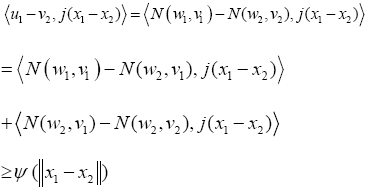
Which implies that the mapping S=N (T(.), F(.)) is uniformly accretive.
Lemma II.2 Let E be a real Banach space and  be a lower semicontinuous, m-accretive mapping, then the following conditions holds;
be a lower semicontinuous, m-accretive mapping, then the following conditions holds;
(i) T admits a continuous and m-accretive selection
(ii) In addition, if T is also uniformly accretive, then it admits continuous, m-accretive and uniform accretive selections
Proof: The proof of (i) follows from the proofs of
Lemma I.1 and Lemma I.2 (b). For any given  and for any
and for any  , we have from the result of Lemma II.1 that
, we have from the result of Lemma II.1 that

Letting  we obtain
we obtain
 which implies that h is uniformly accretive
which implies that h is uniformly accretive
Now, since T and F are both Lipschitzian, it follows from Eq. 5, that

In the same vein,

This implies that given any  the iterative sequences un and vn are cauchy sequences. Therefore, there exists
the iterative sequences un and vn are cauchy sequences. Therefore, there exists ,
,  such that
such that By Lemmas II.1 and II.2 and results in results in [5,6,10] we infer that
By Lemmas II.1 and II.2 and results in results in [5,6,10] we infer that  too is uniform accretive.
too is uniform accretive.
Thus, there exist  and
and  such (8) and establish the results
such (8) and establish the results  in Appendix A with ‘less’ continuity restrictions
in Appendix A with ‘less’ continuity restrictions
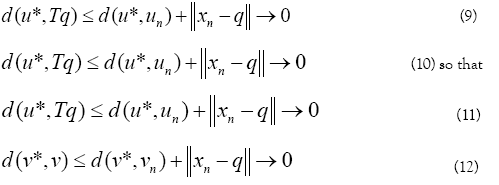
Appendix A
Consequence of Proof of Theorem I.6 and and Lemma I.7
Claim A.1. To prove Theorem I.6 and Lemma I.7, the claim is made that [11-13]
 (13)
(13)
Proof of Claim:There exists n0 such that for any  ,
,
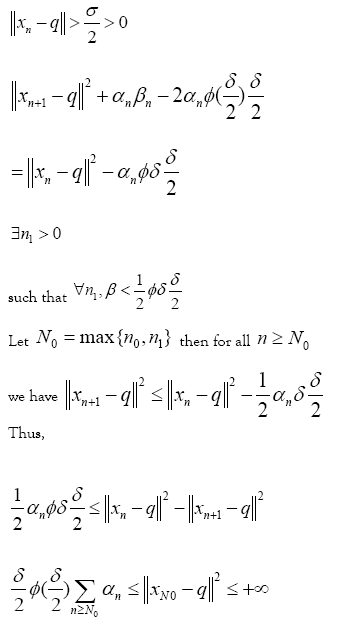
 and there exists
and there exists 
 as
as . That is, ∀n ≥ 0
Which
implies that
. That is, ∀n ≥ 0
Which
implies that  as
as  Now using the fact that T is µ
Now using the fact that T is µ
Lipschitzian and F is ∈Lipschitzian, it follows that from Eq. 5 that


And
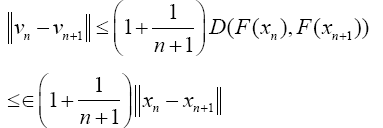
This result implies that the sequences un and vn are Cauchy sequences. Therefore, there exists  such that
such that 
 . Next, we prove that
. Next, we prove that  In fact, since,
In fact, since,

 (14)
(14)
Result of Eq. 14 implies that  Similarly, Eq. 15 also implies that [14,15]
Similarly, Eq. 15 also implies that [14,15] 
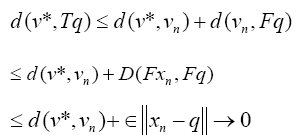 (15)
(15)
It remains to show [16] that  But Eq. 16 and 17 clearly shows this.
But Eq. 16 and 17 clearly shows this.
 (16)
(16)
Which implies that  and since;
and since;
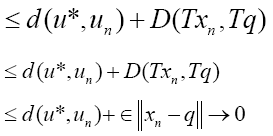 (17)
(17)
This implies u*= v. [17] Summing up the above argument we conclude that the sequences xn,un and vn defined by Eq. 5, converges strongly to solution (q, u, v) of problem 1 respectively.
REFERENCES
- Hartman P, Stampachia G. On some nonlinear elliptic differential-functional equations. Acta Mathematica. 1966; 115:271-310.
- Michael E. Continuous selections , Annal of Mathematics. 1956; 63: 361-382.
- Nadler SB. Multi-valued contraction mappings. Pacific Journal of Mathematics. 1969; 30: 475-488.
- Chang SS. Set-valued variational inclusions in Banac Spaces. Journal of Mathematical Analysis and Applications. 2000; 248: 438-454.
- Moore C, Nnoli BVC. Iterative solution of nonlinear equations involving set-valued uniformly accretive operators. Computers & Mathematics with Applications. 2001; 42: 131-140
- Morales CH. Surjectivity theorems for multi-valued mappings of accretive type. Commentationes Mathematicae Universitatis Carolinae. 1985; 26: 397-413.
- Koboyashi Y. Difference approximation of Cauchy problems for quassi-dissipative operators and generation of nonlinear semigroups. Journal of Mathematical Society Japan. 1975; 27: 640-665.
- Chang SS. The Mann and Ishikawa Iterative Approximation of solutions to variational inclusions with accretive type mappings. Computers & Mathematics with Applications.1999; 37 :17-24.
- Chang SS, Cho YJ, Jung JS, et al. Iterative approximations of fixed points and solutions for strongly accretive and strongly pseudo-contractive mappings in Banach Spaces. Journal of Mathematical Analysis and Applications. 1998; 224: 149-165.
- Martin RH. A global existence theorem for autonomous differential equations in Banach spaces. Proceedings of the American Mathematical Society. 1970; 26: 307-314.
- Deimling K. Nonlinear Functional Analysis. Springer-veriag, Berlin. 1985; 10-25.
- Demyanoy VF, Stayroulakis GE, Polyakoya LN, et al. Quassidifferentiability and Nonsmooth Modelling in Mechanics, Engineering and Economics. Kluwer Academic, Dordrecht. 1996.
- Ding XP. Iterative process with errors of nonlinear equations involving M-accretive operators. Journal of Mathematical Analysis and Applications. 1997; 209:191-201.
- Hassouni A, Moudafi A. A perturbed algorithm for variational inclusions. Journal of Mathematical Analysis and Applications. 1997; 185:706-712.
- Noor MA. Generalized set-valued inclusions and insolvent equations. Journal of Mathematical Analysis and Applications. 1998; 228 :206-220.
- Jung JS, Morales CH. The Mann process for perturbed m-accretive operations in Banach spaces. Nonlinear Analysis. 2001; 43:231-243.
- Showalter RE. Monotone operators in Banach Spaces and nonlinear partial differential equations. Mathematical Surveys and monographs. 1997 ;49.






